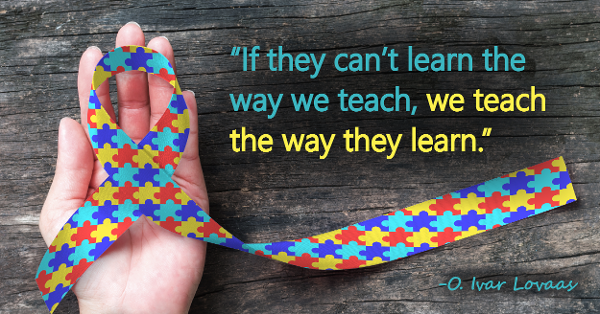
Substitute teachers may find it challenging to work with students who have autism, since the students may be thrown off by the change in routine. The first and most important concept to remember is that every child on the autism spectrum has unique abilities and challenges – therefore, every student you teach will benefit from different styles of support.
Some of the common characteristics of autism include difficulty with social interactions/communication, resistance to change, and sensitivity to sensory stimuli. We’re confident that by employing some of the tips listed below, your experience working with students with autism will be both interesting and rewarding.

Arrive early and give yourself a bit of extra time to familiarize yourself with any lesson plans, notes, or IEP information left for you by the teacher. Preparation will help your day go smoothly.

Many classrooms that have students with autism feature a paraprofessional or aide who will be a great resource to you. It’s okay to let the para take the lead since they know the students and the daily routine. Make sure to be supportive and flexible.

The teacher will likely leave detailed lesson plans to help you navigate your day. Be sure to follow plans closely, as they may include IEP modifications and accommodations for specific students which are important to follow.

Many students with autism are resistant to change. Opening the day by introducing yourself in a friendly and warm manner and assuring students that it will be a good day can go a long way to quell any anxiety they may have.

It’s helpful to have your schedule displayed visually as transitions can be a struggle for students with autism. The classroom may already be equipped with a bulletin board or poster specifically for this purpose. If not, write the schedule on the board. Your students will feel more secure if they know what to expect throughout the day.

Even when you have the schedule displayed, it’s prudent to give students advance warning before transitioning to another subject or leaving the room for lunch or a special. This gives students time to process the change before acting. It’s especially important to prepare students for unexpected changes to the daily schedule (like an assembly) by explaining the situation and delivering clear directives.

Communication difficulty is a common characteristic of autism. When speaking to a student, allow several seconds for the student to respond before you speak again. It may take the student a moment to process your words.

When speaking to students with autism, use a calm, kind, and direct voice with simple sentence structure. Avoid using figurative language, sarcasm, and idioms – many students won’t comprehend their meaning and may take you literally.

Deliver instructions in multiple ways to foster comprehension. For instance, you can write instructions on the board, read them aloud, and even model them to your class. Avoid giving more than two steps at a time. More complex tasks should be broken down into one- to two-step sections. Using “first/then statements” will also help your students process instructions in the correct sequence.

Punishment may only serve to exacerbate anxiety in students with autism, and may even have the reverse effect of your intention. Focusing on positive reinforcement is your best bet. Incentivize students to behave appropriately by working toward a small reward. Take notice and comment when your students are behaving well. If students are misbehaving, have patience, and calmly redirect them toward positive behavior without getting angry or emotional yourself.

Students with autism may have difficulty interacting with peers. Make it a point to promote social interaction and inclusion to help them build social skills and feel more comfortable in social situations. Always promote an atmosphere of tolerance and respect.

By substituting frequently within the same school (even if it’s not always the same classroom), you’ll become a familiar and trusted face in the building. Students will feel more comfortable with you once you’ve built rapport – and that makes your job a lot easier!
To further expand your perspective on teaching students with autism, we suggest checking out the following articles:
- 8 Tips for Helping Children with Autism During COVID-19
- 12 Things I’d Like Teachers to Understand about Autism from Autism Speaks
